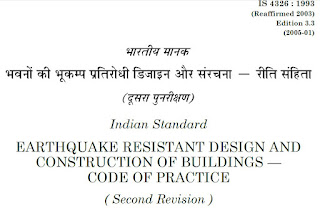IS-4326: 1993 EARTHQUAKE RESISTANT DESIGN AND CONSTRUCTION OF BUILDINGS — CODE OF PRACTICE( Second Revision )
About IS-4326 : 1993
This Indian Standard was adopted by the Bureau of
Indian Standards, after the draft finalized by the Earthquake Engineering
Sectional Committee had been approved by the Civil Engineering Division
Council. Himalayan-Naga Lushai region, Indo-Gangetic Plain, Western India and
Kutch and Kathiawar regions are geologically unstable parts of the country and
some devastating earthquakes of the world have occurred there.
The following are the major changes besides minor
amendments affected in this revision of the standard:
a) Low strength brickwork and stone masonry are
removed and developed into a separate standard;
b) Clauses on ductility details have been removed
and developed into a separate standard;
c) Building categories have been introduced based on
basic seismic coefficient, soil-foundation factor and importance factor as per
IS 1893: 1984; and
d) Size and position of openings in bearing walls
has been specified in greater detail.
In this standard, it is intended to cover the
specified features of design and construction for earthquake resistance of
buildings of conventional types. In case of other buildings, detailed analysis
of earthquake forces will be necessary. Recommendations regarding restrictions
on openings, provision of steel in various horizontal bands and vertical steel
at corners and junctions in walls and at jambs of openings are based on a range
of calculations made using steel design seismic coefficient and the ductility
of steel reinforcement. Many of the provisions have also been verified experimentally
on models by shake table tests.
The Sectional Committee responsible for the
preparation of this standard has taken into consideration the views of all who
are interested in this field and has related the standard to the prevailing
practices in the country. Due weightage has also been given to the need for international
co-ordination among the standards and practices prevailing in different
countries of the world.
This edition 3.3 incorporates Amendment No. 1
(December 1995), Amendment No. 2 (April 2002) and Amendment No. 3 (January
2005). Side bar indicates modification of the text as the result of incorporation
of the amendments.
For the purpose of deciding whether a particular
requirement of this standard is complied with, the final value, observed or
calculated, expressing the result of a test or analysis, shall be rounded off
in accordance with IS 2 : 1960 ‘Rules for rounding off numerical values ( revised
)’. The number of significant places retained in the rounded off value
should be the same as that of the specified value in this standard.
Download Now

![Different Applications of GIS [ Geographical Information System ]](https://blogger.googleusercontent.com/img/b/R29vZ2xl/AVvXsEhHuGl0hPEHKOfNPmTyBacOw3n4QQS54eRbfvEJfHxbOdImzfdroP0ab3tvCp98S2P8ZvJWqiz1clCwaQGVp2i9t9Nq4UkvRgcIR9X_chyphenhyphenkBJmhr4UIJRs4Jw0ppSn6jn56sVfBed4j9i7J/w100/8113229957_421c837a06_b.jpg)

![[PDF] IS 456 2000 | Download Civil Engineering Code](https://blogger.googleusercontent.com/img/b/R29vZ2xl/AVvXsEjl8mzhZI_smGwhJPipCx2TuxHldgAvnHrYfkud8mDJ1kF4Syd83-TNKsXjyY1BVxFrxZ1tt-fErpupgiF146wqOfPtGo8M9GWrnQX9b9TyA-YtjlNWnlwdk9LaMN_JJN8AGCU619UI6Uu_/w100/is-456-2000.JPG)



![[PDF] SP 16 :1980 Design Aids For Reinforced Concrete to IS : 456-1978](https://blogger.googleusercontent.com/img/b/R29vZ2xl/AVvXsEj3vWyWR9sVpY2Mcip5F3ttq_4jje6Et0mqiBug-q8n7kClvXle3KD0XtZBwYBtmYFfIekvQYIW9gFB5aqcri6KrHD4x2PalOyEWAXPkLNFfbXe8m9m8WvCLSEWok7vPivvYidB1tj8JjeX/w100/is-sp-16-1980.JPG)
![[PDF] Download IS 800 Code | Indian Standard Code for Steel](https://blogger.googleusercontent.com/img/b/R29vZ2xl/AVvXsEjMmVdQd3q6sKYLbOG23DVJg2U_8IrdWJSfCcyA7gKs5NKVFBsi6dFPhGxoVctqzOHEIvJ6pqvQ6mpFMd5vV0U5IQHo-FETwRXTjbZ-Dok9CHxUJgePxHyFTHa2pNiWyW4mkYCJWOv_2IcP/w100/is-800-2007.JPG)

0 Comments